#indian children authors
Explore tagged Tumblr posts
Text

'We thought it was a ball' - the bombs killing and maiming Indian children
Over the last three decades, at least 565 children in the Indian state of West Bengal have been injured or killed by home-made bombs, a BBC Eye investigation has found.
So what are these deadly devices and how are they linked to political violence in West Bengal? And why are so many Bengali children paying the price?
On a bright summer morning in May 1996, six boys from a slum in Kolkata, the capital of India's West Bengal state, stepped out to play cricket in a narrow alley.
Their shantytown, nestled in the middle-class neighbourhood of Jodhpur Park, thrummed with life. It was a holiday - voting day in a general election.
Nine-year-old Puchu Sardar, one of the boys, grabbed a cricket bat and quietly slipped past his sleeping father. Soon, the cracking noise of bat meeting ball echoed through the alley.
A ball batted out of the boundaries of their makeshift pitch sent the boys searching for it in a small garden nearby. There, in a black plastic bag, they found six round objects.
They looked like cricket balls someone had left behind, and the boys returned to the game with their spoils.
One of the "balls" from the bag was bowled at Puchu who struck it with his bat.
A deafening explosion tore through the alley. It was a bomb.
As the smoke lifted and neighbours rushed outside, they found Puchu and five of his friends sprawled on the street, their skin blackened, clothes scorched, bodies torn.
Screams pierced the chaos.
Seven-year-old Raju Das, an orphan raised by his aunt, and seven-year-old Gopal Biswas died of their injuries. Four other boys were wounded.
Puchu narrowly survived, having suffered serious burns and shrapnel wounds to his chest, face and abdomen.
He spent over a month in hospital. When he came home he had to use kitchen tongs to remove shrapnel still lodged in his body because his family had run out of money to pay for any more medical care
Read more
#indian children#society for indian children's welfare#murrow indian children's home#malin's intelligence scale for indian children#american indian children's literature#bob marley indian children#indian children's books#indian children welfare act#indian children poem#indian children praying for trump#indian children clothes#indian children books#indian children annette wynne#indian children academy school#indian children academy school waidhan#indian children actors#indian children authors#indian children academy barau#indian children act#indian children actress#indian children attire#american indian children#a large number of indian children die of#anglo indian children#average indian children's height#apache indian children#autism in indian children#asian indian children#american indian children's literature award#american indian children and the law
0 notes
Text
I've been quiet these days... It's because I co-wrote and published a bilingual children's book set in my home country! Written in English and Spanish, my book is titled JUANITA and it's about the contemporary migrant experience in the Caribbean from a child's perspective.
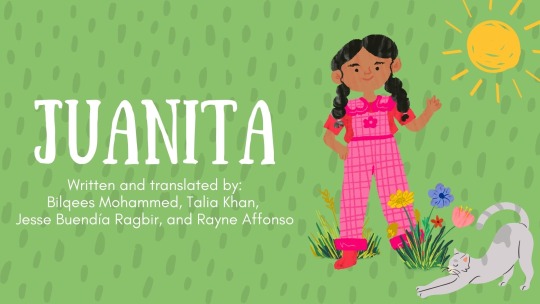
JUANITA is the ideal tool for both children and adults to learn English or Spanish as a second language. It features a main story, reading comprehension questions, vocabulary lists, and written reflection exercises.
And guess what! It's available right now worldwide on Amazon in both Kindle and paperback format!
Link to Kindle purchase: here!
Link to paperback purchase: here!
Link to Goodreads page: here!
Give us a purchase, rate, and review if you would like! For language learners and people looking for Hispanic and/or Caribbean representation, JUANITA is my recommendation to you!
#writer#writeblr#children's literature#children's lit#children's books#langblr#languages#foreign languages#spanish#spanish language#spanish langblr#caribbean#west indian#latin america#latinx#hispanic#book recommendations#book recs#author#debut book#book blog#books#books and literature#language learning#polyglot#bilingual
36 notes
·
View notes
Text
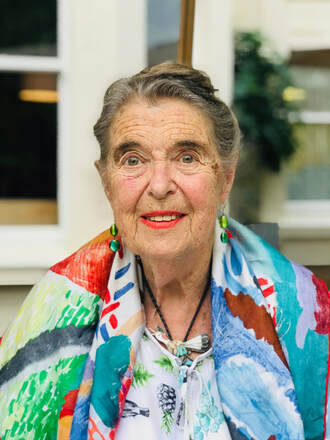

LYNNE REID BANKS (1929-Died April 4th 2024,at 94).British author of books for children and adults.Banks wrote forty-eight books, including the best-selling children's novel The Indian in the Cupboard, which has sold over 15 million copies and has been successfully adapted to film. Her first novel, The L-Shaped Room, published in 1960,was an instant and lasting best seller. It was later made into a movie of the same name and led to two sequels, The Backward Shadow and Two is Lonely. Banks also wrote a biography of the Brontë family, entitled Dark Quartet, and a sequel about Charlotte Brontë, Path to the Silent Country.Lynne Reid Banks - Wikipedia
#Lynne Reid Banks#British Novelists#British Children's Writers#English Novelists#English Children's Writers#Childrens Writers#The Indian in the Cupboard#The L-Shaped Room#Notable Deaths in April 2024#Notable Deaths in 2024#Children Authors
4 notes
·
View notes
Text
What’s Here Wednesday: BIPOC Authors

A delicious book by a BIPOC author that you can find in the TMC is Bilal Cooks Daal by Aisha Saeed! With its themes of friendship and sharing, this book is definitely an uplifting choice for a diverse read-aloud. You can also search online for lesson plan ideas for teaching the book. Additionally, take a closer look around the TMC for even more books by authors of Indian descent: Mina and the Monsoon and Priya Dreams of Marigolds & Masala are a couple of great picks of many more!
#tmc#teaching materials center#Memorial Library#SUNY Cortland#diversity#BIPOC authors#indian#india#cooking#what's here wednesday#picture books#children's books#children's literature
2 notes
·
View notes
Text
Children's book for 5-10 years
Hello readers! Here are reviews of four children’s books for ages 5-8, featuring themes ranging from thrilling adventures and heartwarming animal stories to inspiring protests and captivating biographies. Whether you’re a parent or teacher, these books are wonderful additions to any child’s bookshelf, sure to inspire and motivate young readers. Children’s book for 5-10 yearsPuppy Trouble by…
#Alia Bhatt#Arundhati Venkates#Bijal Vachharajani#Book Blog#book blog feature#Book blogger#Book review#book review blog#Books for young readers#Books Teacup and Reviews#Children Fiction#children nonfiction#Children&039;s book for 5-10 years#Children&039;s Books Recommendation#Indian Author#Indian Book Blogger#Indian readers#Neha J Hiranandani#Penguin Children&039;s books#Petu Pumpkin Freedom Fighter#Puppy Trouble#The Adventures of Ed-a-Mamma#The Padmas
0 notes
Text
Fearless Sia and the Mystery of the Spooky Mansion | Saurabh Akhauri | Book Review
Publisher : Independently Published; First Edition (31 August 2022) Language : English Hardcover : 160 pages Reading Age: 7 years and above Fearless Sia and the Mystery of the Spooky Mansion by Saurabh Akhauri is a one-of-a-kind storybook that revolves around the 12-year-old Sia who lives in Oldsville. Nothing exciting happens in the sleepy town until the arrival of the Summer…

View On WordPress
#Book Recommendations#Book Reviews#Bookish Fame#Children Books#Fearless Sia and the Mystery of the Spooky Mansion#Indian Authors#Saurabh Akhauri
0 notes
Text
Good News - July 8-14
Like these weekly compilations? Tip me at $Kaybarr1735! And if you tip me and give me a way to contact you, at the end of the month I'll send you a link to all of the articles I found but didn't use each week!
1. Zoo welcomes birth of four endangered horse foals
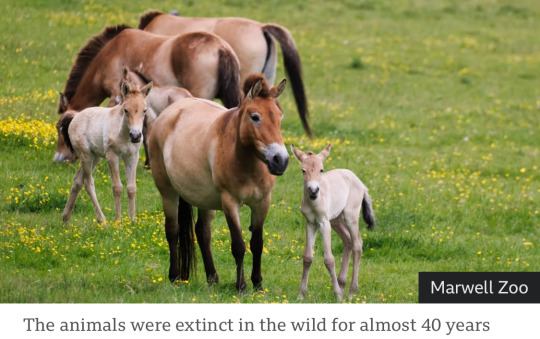
“[The Marwell Zoo in GB] said it was "delighted" to welcome the arrivals to the endangered Przewalski’s horse herd. All four are female and said to be "doing well" after two were born in May and two in June. […] “These horses, that were previously listed extinct in the wild, are an example of how zoo breeding programmes can help restore threatened species around the world.” […] All the Przewalski’s horses alive today are descended from just 12 individuals. Current estimates suggest there are 178 mature individuals living in the wild.”
2. Restoring woodlands and planting trees for sustainability success

“In 2023, [the Marwell Zoo] planted 9,000 new trees […] both within the zoo and on our surrounding land. […] Marwell tries to encourage natural feeding behaviour and nutrition by including leafy material [in animals’ feed] as much as possible. […] Planting more trees and enhancing management of our existing woodlands, prepares the way to further self-sufficiency in browse production in the future. Plus, it creates new habitats for wildlife in our woodland areas.”
3. Inclusive Playgrounds Allow Children Of All Abilities To Play

“With ramps allowing children in wheelchairs to ascend the central play structure, as well as numerous other swings and apparatus usable for children of all abilities, the 16,000-square-foot P.K.’s Place is St. Paul’s first fully inclusive playground. […] To be universally accessible, a play area must have at least 70% of its play features fully accessible, far more than required by the Americans with Disabilities Act (ADA). […] Play areas should allow parents and grandparents with disabilities to participate as well.”
4. Combination treatment can increase human insulin-producing cells in vivo
“[Diabetes-model mice] were treated with the combination therapy [of a plant product called harmine and “a widely used class of type 2 diabetes therapy”] and their diabetes was rapidly reversed. Strikingly, human beta cell numbers increased by 700 percent over three months with this drug combination. "This is the first time scientists have developed a drug treatment that is proven to increase adult human beta cell numbers in vivo. This research brings hope for the use of future regenerative therapies to potentially treat the hundreds of millions of people with diabetes," said Dr. Garcia-Ocaña, the paper's corresponding author.”
5. Decades of Dedication: Australia’s Largest Ongoing Urban Restoration Project

“[Friends of Lake Claremont] has transformed the area into a thriving ecosystem, re-establishing native habitats and fostering biodiversity. This year, 800 native seedlings (100 trees, 350 shrubs and 350 ground covers) have been planted on the northwestern buffer of Lake Claremont. Volunteers replaced a large Port Jackson fig (Ficus rubiginosa) affected by [beetle] infestation with native plants to enhance the local wildlife habitat, thereby benefiting insects, frogs, birds and brown bandicoots. […] Overall, the project contributes to the area’s function as a regional ecological corridor, linking inland bushlands, the Swan River and the Indian Ocean.”
6. Important habitat for fish in Heart of the Fraser now conserved

“British Columbia’s iconic salmon now have more protected spawning habitat in the lower Fraser River, thanks to the Nature Conservancy of Canada’s (NCC’s) conservation acquisition of Carey Island. […] Carey Island and its gravel channels offer calm and crucial spawning and rearing habitat for the river’s fish and aquatic species. […] The Pelólxw Tribe […is also] actively working to restore the resilience of aquatic habitat within this stretch of the Lower Fraser. NCC is exploring opportunities to collaborate with the Pelólxw Tribe in support of their vision for stewardship of the area, which prioritizes both ecological and cultural values.”
7. Prime editing efficiently corrects cystic fibrosis mutation in human lung cells
“[R]esearchers have developed a gene-editing approach that efficiently corrects the most common mutation that causes cystic fibrosis, found in 85 percent of patients. With further development, it could pave the way for treatments that are administered only once and have fewer side effects. The new method precisely and durably corrects the mutation in human lung cells, restoring cell function to levels similar to that of Trikafta [the standard treatment since 2019].”
8. Montana’s High Court Considers a Constitutional Right to a Stable Climate
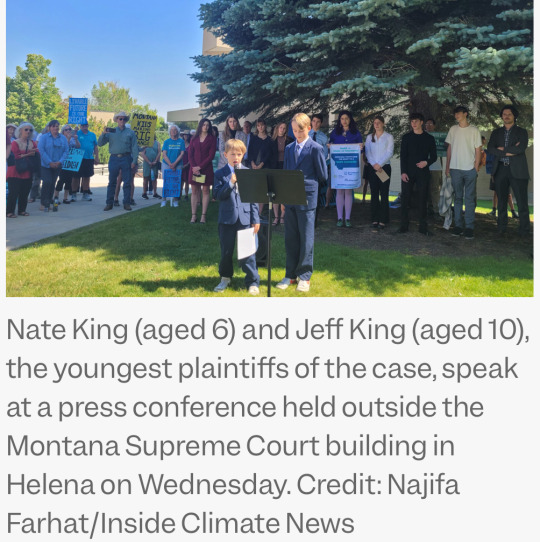
“At issue was the appeal of a decision last year, when a Montana judge blocked a state law that prohibited agencies from considering climate impacts when deciding whether to approve fossil fuel projects such as new power plants, pipelines or mining. The ruling, by District Judge Kathy Seeley, was prompted by a lawsuit filed by 16 youths who argued that the law violated Montana’s constitutional right to a “clean and healthful environment.” It was the first ruling in the United States to effectively establish constitutional rights to a stable climate[….]”
9. The US is about to get its first solar-covered canal

“The first canal-based solar project in the U.S. is nearing completion on tribal lands south of Phoenix, Arizona. […] The long, narrow solar array design would snake along the line of the canal and tap into the local electrical distribution grid every 1,000 feet, or every one megawatt. […] “Canal solar allows for greater power production per land size, cleaner water, less power transmission losses, and significant reduction in evaporation[….]” Covering the entire 8,000 miles of canals and waterways managed by the Bureau of Reclamation with solar panels could generate over 25 gigawatts of renewable energy and reduce water evaporation by tens of billions of gallons[….]”
10. Camera traps offer glimpse of first beaver born in Northumberland for 400 years
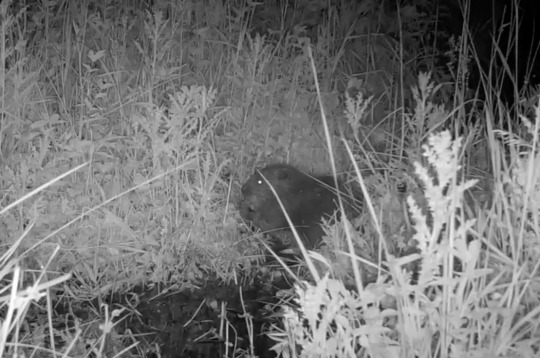
“"It’s such a relief that they have bred successfully and to see a new fluffy kit swimming with the family[….]” In just one year [since releasing the beavers], there has been a noticeable increase in resident trout, says the National Trust, along with more regular visits from kingfishers and grey herons. There are more insects at the site, too, thanks to the organic matter that builds up behind the dams, which in turn provides food for Daubenton’s bats. […] Beavers also play an important role in creating habitats that are more resilient to the effects of climate change[….]”
July 1-7 news here | (all credit for images and written material can be found at the source linked; I don’t claim credit for anything but curating.)
#hopepunk#good news#horse#zoo#nature#extinct species#sustainability#forest#children#disability#playground#disabled#wheelchair#diabetes#medicine#science#urban#biodiversity#ecosystem#fish#first nations#cystic fibrosis#gene editing#climate change#climate#youth#human rights#solar panels#solar energy#beaver
330 notes
·
View notes
Text
"The Ayla Descent Theory" of Mary Sues

"Children of the Earth," Luis Royo.
After the success of Jean M. Auel's stone age novel Clan of the Cave Bear, there was a very lengthy trend in the publishing world of stone age adventure novels aimed at women that lasted for a decade and only really fizzled out in the early 2000s. After all, "Ayla," the name of the main character of these books, was one of the top baby names of 1987.
The target audience for these books were weird midwestern aunts....you know, the Mists of Avalon and the Mercedes Lackey/Valdemar audience. Therefore, the Clan of the Cave Bear imitators also featured things of interest to the weird aunt audience: Scotland, redhaired women with sharp tongues, commanding wolves, Ireland, Feminism, riding herds of wild horses bareback in scenic locations, Wicca, matriarchial religions, swimming with dolphins....but above all else, American Indians (a culture this audience finds interesting, as anyone who has seen the home decor of a typical weird midwestern aunt can attest), with many novels set in Ice Age America, like Children of the Dawn, Reindeer Moon and the First Americans. Decades later, this audience would form the core fandom for Game of Thrones, and the character of Khaleesi Targaryen in particular.

These books almost assuredly still have a place of honor on the book shelf of the weirdest woman at your job.
Nearly all of these imitators have two of Clan of the Cave Bear's defining traits: 1) a supremely beautiful, usually blonde athletic and statuesque main character over 5'11" who does not realize that she is so beautiful and desirable, who is good at a variety of different skills and is friendly with animals like hawks, dolphins, or horses, and 2) a love triangle between this aforementioned blond but innocent Venus and two bodybuilder muscular he-men cave hunks, one of whom is a blonde guy with long rock star hair (it was the 80s), and the other being a buff black guy with dreadlocks (or otherwise ethnic in some way).
The heroine usually picks the blonde guy in the end, but the audience usually picks the ethnic guy.
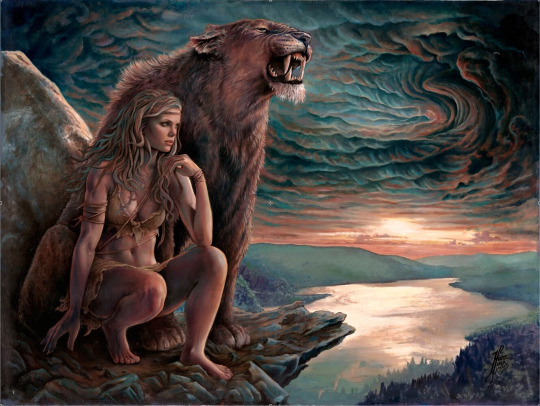
In the late 90s and early 2000s, in the broader culture of fandom, it was fashionable to dump on "Mary Sues" (indulgent wish-fulfillment author personas in fanfiction) and the people who wrote them. Accusations of creating a Mary Sue approached a kind of hysteria. Even at the time, when everyone else was getting swept up in this, I thought that getting mad about aunties writing fanfiction showed a loss of perspective, and was a bit silly. Thankfully, we've benefitted from moral evolution: the consensus in fandom now is that writing aspirational characters is a harmless activity that tests a young writer's creative muscles, like the half-Vulcan pretty new ensign on the Enterprise that Kirk and Spock both fall in love with, or a new archer girl who Legolas falls in love with joining the Fellowship. This hate walked hand in hand with insecurities, in the exact same way that people worried about their appearance or concerned with their weight are often cruel to fat people, and there were frequent tests if this or that character in your writing was a Mary Sue.

There was a running joke in this 2000s culture of anti-self insertion called the "Ayla Descent Theory of Mary Sues." The joke was that Mary Sues came into existence because Ayla, the beautiful, athletic heroine of the Clan of the Cave Bear novels, was the ancestor of their entire lineage, as the first known Mary Sue to ever exist in the historical record, described as being a statuesque blonde who did everything right and was always at the center of love triangles, and who changed human history.
According to the running joke, Mary Sues everywhere were descended from Ayla from Clan of the Cave Bear, and she was the first to exist, and Ayla was the explanation of where all the Enterprise's new ensigns main characters fall in love with come from.
484 notes
·
View notes
Text
Canada, Truth & Reconciliation, & Indigenous Games
Hello friends,
Today (September 30th) is the National Day of Truth & Reconciliation in Canada. It is a very recent holiday in this country, and it’s also very important to me. I want to spend some time today telling you about it, and then (since this is a ttrpg blog) directing you to some indigenous storytellers and designers that deserve a spotlight for various reasons.
I am not Indigenous. This information is a collection of knowledge that I have gained through university coursework, personal research I've undertaken, and relationships I've cultivated with indigenous friends who have taken pains to educate me and highlight how these issues have personally affected them. I am aware that the summary I'm providing is incomplete, and there may be elements that I don't fully understand the implications of.
If you are Indigenous, please keep in mind that this post may recall some painful and personal moments of history for you. Proceed with caution. The shout-outs to indigenous creators can be found after the heading “The Storytellers.”
The Truth.
Canada has been engaged in a cultural genocide of its indigenous peoples since European settlers started the colonization of the country. This genocide had many avenues, including the creation of the Indian Act, the relocation of many Indigenous peoples to restricted Reserves, and a disturbing trend of missing and murdered Indigenous women. For the purposes of today however, I’m going to stick to just talking about Residential Schools, and the impact they had on Indigenous families and their children.
Residential schools were designed to “kill the Indian” and “save the child”, in the words of John A Macdonald, the prime minister who authorized their creation. They were designed to sever Indigenous children from their culture and raise them in a Christian, colonial context. These residential schools were harsh, forbidding Indigenous children to speak their mother tongues, cutting their hair, and forcing them to learn skills considered “useful”, in the language of the colonizer, away from their parents. The schools were also hotbeds of abuse. Alarming numbers of children fell ill and died at these schools - the death toll to this day is unknown. From April 1, 1920 to some time in the 1990’s, residential school attendance was mandatory for Indigenous children from the ages of 7 to 16.
The Sixties’ Scoop is a reference to a mass kidnapping of Indigenous children in the 1950’s and 60’s, who were forcibly removed from their homes and “adopted” into non-Indigenous families. While the last residential school in Canada closed in 1997, Indigenous children still make up over 50% of all children in private foster care, despite only accounting for just over 7% of all children under age 15 in Canada.
The Reconciliation.
Reconciliation is a goal prompted by Indigenous groups and elders. It is a choice that promotes "balance and harmony," a way of life that encourages coexistence, according to the words of one residential school survivor, Hereditary Chief, Dr. Robert Joseph.
In 2007, The Indian Residential Schools Settlement came into effect, offering compensation to survivors of many residential schools.
In 2008, the Truth and Reconciliation Commission of Canada was officially launched, intended to be a guide for the Canadian government to help establish lasting reconciliation. This commission was a way to formalize a method of collecting data, and it also had the responsibility of developing a list of recommendations for the country of Canada to follow, in the goal of pursuing a relationship between the Indigenous peoples of Canada and the government of Canada.
In 2007, Cindy Blackstock, a First Nations (Gitxsan) activist launched a court case against the Canadian government, for under-funding social services provided to children living on First Nations reservations. This was in regards to Jordan’s Principle, a child-first Canadian policy that is meant to ensure that First Nations children have equal access to all government funded public services as other Canadian children. The Truth and Reconciliation Commission made the respect of Jordan’s Principle one of its 94 Calls to Action for the Canadian government.
The Canadian Human Rights Tribunal became involved in 2016, when they found more alleged breaches of the Canadian Human Rights Act in regards to Jordan’s Principle. As of September this year, the Federal Government is still attempting to dismiss human rights complaints regarding the use (or, in fact, neglect) of Jordan’s Principle.
Canada’s history of residential schools and use of the foster care system has grievously wounded Indigenous families and children. The disruption of family life and the forcible removal of children from their culture has created legacies of loneliness, pain, and suicide. Indigenous people today can trace their own familial wounds to the legacy of residential schools and the lack of resources provided to them from the government. The National Day of Truth and Reconciliation is a day to remember this legacy and provide a space for education, but it isn’t enough.
You can learn more about this day and the history behind it by visiting the National Centre for Truth and Reconciliation Website.
You can also watch this 18-minute Youtube video about Residential Schools, or We Can’t Make the Same Mistake Twice, a free 2 & 1/2 hour documentary about Blackstock's continuous fight regarding caring for children using Jordan’s Principle.
I also recommend 21 Things You May Not Know About The Indian Act, by Mary-Ellen Kelm and Keith D. Smith, which breaks down some of the key elements of the Indian Act for everyday person.
So, how do we connect this to ttrpgs?
When it comes to the milestones that have been achieved in Canadian history, those milestones have been made because we listened to Indigenous voices. The recommendations made by the Truth and Reconciliation Commission that have been followed are having real and positive effects for Indigenous peoples in Canada. Listening to the stories of Residential School survivors has been integral to the processes recommended and undertaken by the Canadian government.
We need Indigenous stories. We need Indigenous storytellers.
The Storytellers
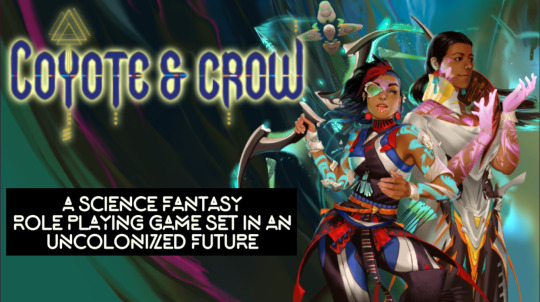

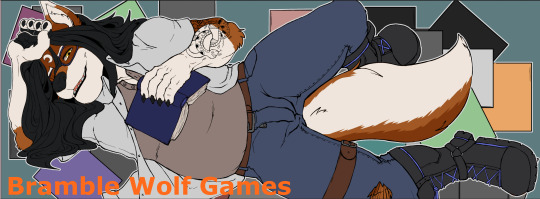
Coyote & Crow.
Coyote & Crow Games is a tabletop games publisher, primarily focused on the tabletop roleplaying game, Coyote & Crow. This is a world and game whose design team is fully Indigenous, from various First Nations people groups across North America. Coyote & Crow is a futuristic game about a land untouched by colonization, a land changed by a series of climate events that have changed the geographical and social landscape. It involves supernatural powers, a completely unique form of civil organization, and a unique d12 dice pool system
In a recent update, Connor Alexander, as the face of Coyote & Crow, announced some business decisions that include a creation of a consultant branch of the company, to provide professional consultation services for other creative endeavours that are looking to include Indigenous Representation in games.
What I love most about Coyote and Crow is that it’s a world where Indigenous creators have been given full reign over the ways they are represented in the fiction, and it provides a unique social and political imagining of society that pulls from many First Nations cultures. It’s refreshing, it’s exciting, and it provides a lot of guidance for non-Indigenous players so that they can engage with the world in a way that’s respectful.
Wendigo Workshop
This is a small team based in Quebec, Canada. I’m not entirely sure whether the team is fully Indigenous, but there are Indigenous creators as part of the team.
Currently the Workshop is working on a number of different games, including… Anomaly Hunters; a monster hunting ttrpg built on the Breathless SRD. Arkelon Chronicles; a science-fantasy ttrpg surrounding the discovery of an Alien ruin. Last Hope; a Caltrop Core game about magical girls fighting to protect the world while balancing their student lives.
Bramble Wolf Games
@sahonithereadwolf is an Indigenous creator based in Appalachia looking to make games that mean something. I found out about him through his game Exceptionals, a game about community, activism and kinetic eye beams. It’s inspired heavily by X-Men, but instead of telling superhero stories, it’s more about the fostering of a community outside of the systems created and enforced by colonial governments.
Sahoni is also currently working on a game called Protect the Sacred, a game inspired by Indiana Jones, but focused on the protection and preservation of monsters and artifacts in the interests of the cultures that have been stolen from by colonial powers. The game is about your relationship to your culture, and resistance to fascism - and you can get sneak peeks to this game through Sahoni’s Patreon.
Both Protect the Sacred and Exceptionals involve character creation that requires players to answer questions about who they are, what they do, and how they affect the community around them. They both recognize the community around you as integral to your success, and I think that this point of view is such an important concept to consider when using games as an art form that can expand your social imagination.
Also...
There is a consultancy service in Alberta, Canada called Pe Matawe Consulting, which is not focused specifically on ttrpgs, but does provide consulting for various creative endeavours. They provide consulting services as well as workshops, with the goal of providing a broader understanding of Indigenous culture and folklore.
162 notes
·
View notes
Text
Reconnecting Cherokee Masterpost
I’ve had a few Cherokee posts blow up on here and as a result I’ve gotten lots of ‘my grandma said she was cherokee’ ‘I’m supposed to have Cherokee roots I wish I knew anything about it’ ‘I was never taught anything about my Cherokee ancestry’ type sentiments in my activity. So! I wanna make a little masterpost with some resources on how to verify or disprove these types of family stories and how to get started for those interested in reconnecting!
A little about me and a disclaimer. I’ve not been reconnecting that long, about a year and a half, and before that I didn’t know I was Cherokee. I did not grow up Cherokee and I am white. What I’m going to be talking about is simply resources for genealogy, language, good places to connect online, etc. these are all things I’ve dealt with as I reconnect, but I am not any sort of authority on Cherokee issues or culture. The purpose of this post is to get people who know absolutely nothing about Cherokee identity and community started in learning more and seeing what needs to be done before reconnecting. And I acknowledge that the genealogical records and resources available for Freedmen descendants and Afro-indigenous people may not be as conclusive, and I simply urge Afro-indigenous people to do what research you can. I am also only Cherokee, I can’t speak for how any of this works for other tribes. Now, to get started
I’ll be talking about
Genealogy
Enrollment
Basic info about Reconnecting
and Language
Genealogy
Genealogy is the most important first step for anyone wanting to reconnect, or even just wanting to claim Cherokee ancestry at all. Unless you have done genealogy research that has shown ancestry connecting you to ancestors on the accepted Cherokee rolls or you are or have family who are citizens of one of the 3 federally recognized Cherokee tribes, please do not make claims of Cherokee identity or ancestry.
Fake ‘granny stories’ of Cherokee ancestry are very common, particularly in the South / Appalachia. These stories often go something like ‘my great-grandmother was fullblood Cherokee. She hid out from the soldiers rounding the Cherokee up for the Trail of Tears.’ There are many many variants, such as children being adopted by a white family, being traded away, or just otherwise being left behind or abandoned. I also frequently see ‘they escaped and hid in the mountains,’ ‘they pretended to be white / black,’ etc. Remember, the Trail of Tears happened in 1838, 185 years ago. My ggg grandfather was 2, so unless you are 60+ it would be unlikely that a great grandparent was alive during that period. This mythical great-grandmother is also occasionally an ‘Indian princess.’ There are many excuses for why ancestors might not show up on known Cherokee records, such as ‘the records were burned in a courthouse fire’ or ‘they were intentionally removed from the records,’ etc. Physical features are also claimed to prove stories, such as high cheekbones, dark hair, darker skin, etc. Old family photos showing grandparents with tan skin, etc, are also brought up pretty frequently. None of those prove anything, as many people of European or mixed ancestry can have these traits. Stories like this are also not exclusive to white families, they can definitely be present in Black families as well. These stories are most often entirely fabricated or resulting from a misunderstanding. It’s pretty common to have someone be familiar with the fake stories but convinced that their family story is the one exception and has to be real, which ends up being instantly caught as fake by anyone that knows the history, you’d be surprised haha. Here is a post I’ve made talking about fake stories in more depth.
DNA testing cannot prove descent from any specific Native tribe. An ‘indigenous American’ result on a DNA test does not prove native ancestry, as DNA tests are frequently wrong especially when it comes to ‘trace ancestry’. Nor does a DNA test showing 0 native DNA prove that one doesn’t have native ancestry. DNA tests are a novelty and irrelevant to native genealogy. The only time they are useful is in finding cousins through DNA matches, which can be especially useful for adoptees. Here is a post where I go more in depth on this
Now, getting into actual genealogy, the main process with Cherokee genealogy is fairly simple. I’m not going to go in depth on the process of genealogy in general, there are plenty of resources for that. Get what info you can from your family [names, birthdates, places people lived] of your recent ancestors, then find their census records [census records from 1950 and earlier are publicly available] or what records you can, and go back, finding their parents, etc. The goal is to get around to 1900. See where they were living at that point, as that will effect what rolls they might be on. There are three main Cherokee rolls that are looked at for determining ancestry [but there are other rolls as well]
The Dawes Rolls taken between 1898 - 1914 recorded the Cherokees living in the Western Cherokee Nation, Indian Territory before Oklahoma Statehood. This roll came with allotments, parcels of land given to the Cherokees. Cherokee Freedmen are also recorded on this roll, along with Intermarried and Adopted Whites. This is the roll that CNO and UKB uses for enrollment. Here is where it can be searched.
The Baker Rolls taken between 1924 - 1929 recorded the Cherokees living on the Qualla Boundary in western North Carolina. This is the roll that the EBCI uses for enrollment
The Guion Miller Roll taken between 1906 - 1911 recorded Cherokees living anywhere and was associated with a cash payout.
I can’t find free searchable databases of the Baker or Miller rolls, but you can find them on some ancestry sites like ancestry.com with a membership or free trial. Also, be aware that these rolls all have “Declined” sections of people who applied and were declined for having no proof of ancestry, mostly just applying to try to get money or land meant for Cherokees. This is especially true of the Miller roll, where 2/3rds of the applicants were declined.
If your ancestors aren’t on any of these rolls, can be found in US census records before 1900, or aren’t living in the Cherokee homelands in the early 1800s, they are almost surely not Cherokee. Also, be wary of results on ancestry sites that start cropping up in the 1700s where the only evidence is another person’s family trees. There are many people claiming descent from Dragging Canoe, Chief Moytoy, and others that put these things on their ancestry trees when none of these people have any descendants. And people will just make up entirely fictional people. Just be sure there are actual documents tying them to the Cherokee and to your ancestors [as people will make up fake children of real figures like Nancy Ward as well]
There is a fantastic resource for Cherokee genealogy in the Cherokee Research and Genealogy Facebook group. The researchers are experts on Cherokee genealogy and will run your lines for FREE and determine conclusively whether you have Cherokee ancestry or not. When they find someone with Cherokee ancestry, they will also find your ancestors’ enrollment applications, allotment locations, etc. they’re really fantastic and I highly recommend checking them out and saving yourself the trouble of doing the research yourself. Just read their rules thoroughly. Even if you did do some research, if you hit a wall or just want confirmation, check them out! Especially if you think you found legitimate ancestry, getting them to double check will remove any doubt.
Enrollment
There are three federally-recognized Cherokee tribes. Each has their own community, resources, and different requirements for enrollment. These are: the United Keetoowah Band [UKB] located in Tahlequah, OK, the Eastern Band of Cherokee Indians [EBCI] in Cherokee, North Carolina, and the Cherokee Nation of Oklahoma [CN or CNO] in Tahlequah, OK. Each of these have distinct histories. Cherokee Nation is the largest by far.
Be wary of fraudulent state-recognized Cherokee tribes. If a Cherokee tribe is not one of the three mentioned above, then it is not recognized by the others as legitimate. These state tribes often take resources that are supposed to be going to legitimate native communities [such as school funding], spread misinformation, etc. These communities often have obviously fake non-Cherokee traits such as ‘naming ceremonies’ and members with laughably stereotypical names like ‘spirit wolf’ and ‘white owl’ lol [also, this is specifically about state tribes claiming to be Cherokee, I can’t speak to the legitimacy of other groups.]
Two of the three Cherokee tribes have a blood quantum requirement. Blood quantum [BQ] is how much ‘native blood’ one has, depicted as a fraction. BQ is a very complex topic in native communities, which I won’t get into here. EBCI has a 1/16 BQ requirement, so to be a citizen you must has 1/16 Eastern Cherokee blood, as well as have an ancestor on the Baker Roll. UKB has a 1/4 BQ requirement, so citizens must have 1/4 Cherokee blood and an ancestor on the Dawes Rolls or the 1949 UKB roll. CNO has no BQ requirement, if an ancestor is listed as By Blood on the Cherokee Dawes Rolls, or listed as a Cherokee Freedman, then you are eligible for CNO citizenship.
Do not come into Cherokee spaces just asking what sort of benefits enrollment can get you. It’s pretty disrespectful and makes it seem like you only care about what you can take from us.
Reconnection
So you did your genealogy and found that you have documented Cherokee ancestry, what next? Reconnection is a long and difficult process and I’ve barely even started, but I’ll try to give what resources and info I can.
Who can reconnect? This can vary between people, but most often I see people [biased towards Cherokees who are active online] saying that anyone with legitimate documented Cherokee ancestry can reconnect. Some people prefer reconnectors are able to enroll in one of the 3 tribes, some prefer people have connected living family, it varies a lot. In my experience as someone who is white and not a citizen yet, if you are respectful and humble, people are pretty accepting. It’s also important to think about why you want to reconnect. You need to be prepared to give back to your people as much if not more than you get. That means learning the language, the history, learn about current issues, etc. Don’t go into it just wanting to be able to say you’re Cherokee as a fun fact or get some sort of monetary benefit. It’s also important to remember that you will get asked to prove yourself. Don’t be offended if you’re asked if you’re enrolled, who your family is, how you’re Cherokee, etc. This is part of our cultural protocols. Not only do we want to keep people with fake family stories from getting into our spaces, we also just like finding relatives! You need to remember your place as a reconnecting Cherokee. Don’t think having legitimate ancestry suddenly means you’re able to talk with authority on native issues or suddenly claim to be oppressed. If you’re white, don’t suddenly start claiming to be a POC or “white-passing,” you can be white and Cherokee. Cherokee is not a race.
Consider Why you want to reconnect. I see a lot of people that want to 'reconnect' seemingly just so they can put cherokee in their bio and feel like part of a special club that can do closed practices and say they're two spirit or whatever. When you reconnect, the most important people will be the rest of the cherokee community. If you're more worried about performing to nonnatives, think long and hard about your priorities.
Reconnecting is a difficult process, especially if you are far from any Cherokee communities. You cannot reconnect alone. You aren’t reconnecting to some distant past, or to stories in a book, you are reconnecting to a living community. This can be tough for people who are far from Oklahoma or North Carolina, and there are some things that are not really possible to learn except in person. But you can still learn, and there are some online spaces. I particularly find the ᎠᏂᏣᎳᎩ ᏍᎦᏚᎩ (Cherokee Community) Facebook Group valuable. It’s kinda small, but it’s one of the best ways to engage with Cherokee community online. Sorry if you’re a Facebook hater, Facebook is going to be your best bet for actually meeting people and engaging. The Cherokee Community group requires proof of ancestry before members can join. This usually just means sending your tribal ID or your thread in the Cherokee Research and Genealogy group to an admin and they’ll let you in.
The best lesson for reconnecting is learning how to shut up and listen. I see way too many people joining cherokee groups as brand new reconnectors and immediately starting to talk and add their input on everything. You need to be able to just watch and learn and take the learning opportunities as they come instead of insisting on having someone go out of their way to teach you. So many people make fools of themselves in this groups by being loud when they have no idea what they're talking about, and insisting they get an Indian name, or wanting tattoos, or wondering if they can say they're two spirit, etc etc all when they don't seem to know anything else about our culture. You need to put work in first. Learn to read syllabary and attend the language classes, look into learning to weave or bead or whatever, get a few books by legit Cherokee authors and read them, binge some osiyo TV, etc etc. Learn what you can give before trying to see what you can take.
Here are some good basic things to check out for reconnecting
OsiyoTV
Cherokee Nation YouTube
Museum of the Cherokee People YouTube
Cherokee Stories of the Turtle Island Liars Club by Chris B Teuton, Hastings Shade, Sequoyah Guess, Sammy Still, and Woody Hansen
Cherokee Earth Dwellers by Chris B Teuton and Hastings Shade
Mooney’s Myths of the Cherokee [note: this was written by a white man in 1900 after after spending some time with the Eastern Cherokee. The history is iffy, but the stories were recorded directly from Cherokee storytellers.]
Trail of Tears: The Rise and Fall of the Cherokee Nation by John Ehle
Do your own research, but be extremely wary of Anything posted publicly online. There is lots of misinformation about Cherokee culture. Personally, I mostly do my learning in the vetted Cherokee Facebook groups, in books written by actual citizens, and by talking with connected friends. Google is rarely your friend in this case.
Language
The language is the center of our culture, it is what makes us Cherokee. It is our duty as Cherokees and as reconnecting people to learn the language. I can’t stress enough how important it is. If you aren’t putting any effort to learn the language, it shows others that you aren’t committed and you will likely have trouble getting any help reconnecting from others, it just looks bad haha. Not saying you have to be fluent overnight, I’ve been reconnecting for a year and I still am very much a beginner, ‘it doesn’t matter how slow you go, as long as you don’t stop’ as CNO language teacher Ed Fields says. Luckily, there are plenty of resources for learning online!
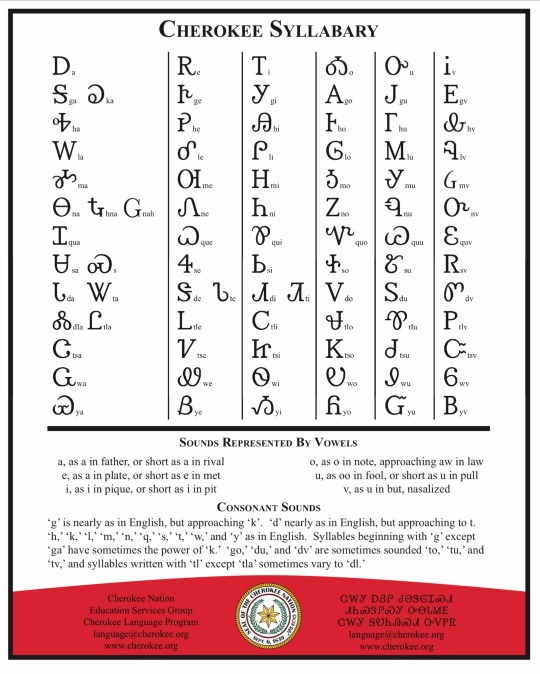
It’s good to learn the syllabary or at least familiarize yourself with it early, as it’s a good introduction to the sounds present in the language. It’s an important part of our culture and the language too. There are also many learning resources that are only in syllabary, so you’re missing out on those if you don’t know it. Here are some good resources for learning:
Simply Cherokee Syllabary by Marc W Case [HIGHLY recommended. I got reasonably confident in syllabary in like a weekend thanks to this book. You can find fairly cheap ebooks versions. It has a story for each character that makes it so easy to remember and associate the characters with their sounds.]
Learn Cherokee Syllabary app [Apple] [Android]
Syllabary fonts and keyboard
There are lots of resources for learning the language. It’s really good to hear it as often as possible when learning vs just reading it, as I’ve messing up so much in my pronunciation from just reading it and now I’m having to break habits. You preferably want to hear first language speakers. There are two main dialects of Cherokee, usually roughly split between Eastern and Western. Dialects vary a lot within those communities as well. If you still have contact with any relatives that speak Cherokee, it’s always better to learn as much as you can from them.
youtube
Cherokee Nation language department [just explore this site, they have lots of resources!]
Cherokee Learner site [explore this site too, this is a great compilation of pretty much every Cherokee language resource, eastern and western]
Online Cherokee Class with first language speaker Ed Fields
RSU Cherokee Lessons [youtube]
Mango lessons
Other apps, including the Memrise course
Online Cherokee dictionary
That’s all I can think to say right now! I’ll probably add to this later as I learn more, find more resources, and get suggestions from others. But for now, good luck, ᏩᏙ, ᏙᏓᏓᎪᎲᎢ !
#Cherokee#tsalagi#ᏣᎳᎩ#ndn#reconnecting#ndn tag#indigenous#Native American#definitely open to corrections and suggestions. please let me know if anything here is wrong or misleading
176 notes
·
View notes
Text


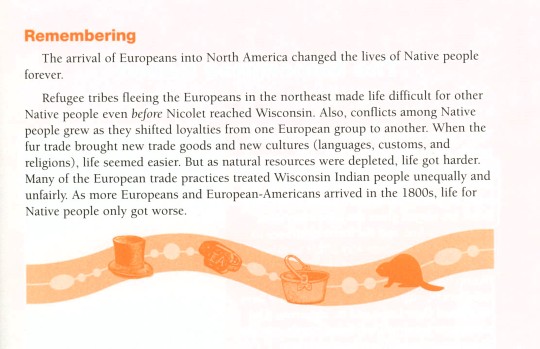
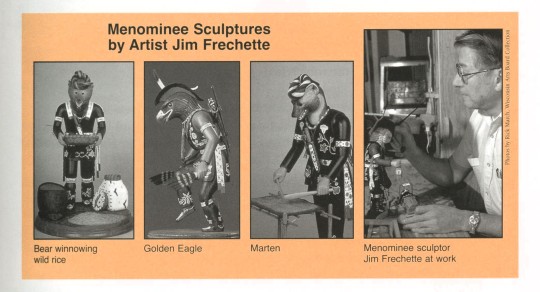

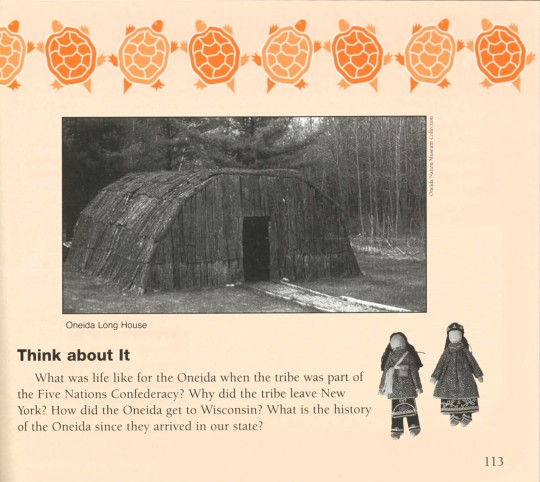


Native Wisconsin
Native People of Wisconsin by Ojibwe scholar and journalist Patty Loew (b.1952), published in 2003 by the Wisconsin Historical Society Press in Madison, Wisconsin, is a book for young readers about the twelve Indian Nations that live in Wisconsin, including my tribe, the Stockbridge-Munsee Band of Mohicans. The book also includes the history of the First People in Wisconsin and the impact of European arrivals on Native culture.
Patty Loew, a Wisconsinite and member of the Bad River Band of the Lake Superior Ojibwe tribe, is a journalist, professor, author, community historian, broadcaster, documentary filmmaker, academic, and advocate. This children's book is a testament to her work, showcasing tribal narratives that encompass different methods through which Indigenous communities preserve their history. With a particular emphasis on oral tradition, this work is a valuable resource for educators and individuals interested in Native American history and will surely captivate young readers.
View other posts from our Native American Literature Collection.
View more from our Historical Curriculum Collection.
-Melissa (Stockbridge-Munsee), Special Collections Graduate Intern
#native people of wisconsin#patty loew#children's books#wisconsin indians#native americans#wisconsin historical society press#indigenous#oral traditions#native american history#native history#native american literature#indigenous peoples#indigenous america literature collection#historical curriculum collection
102 notes
·
View notes
Text
The full list is quite long, so I didn't want to clutter up the last post with it---still, it is impressive to see them all laid out together. So without further ado!
THE 50 MOVIES AND 50ISH BOOKS I WATCHED/READ IN 2024
MOVIES
The Count of Monte Cristo (2024) Emilia Pérez (2024) Wicked (2024) American Psycho (2000) Heavy Trip (2018) La Planète sauvage / Fantastic Planet (1973) The Slipper and the Rose (1973) Bottoms (2023) I Saw the TV Glow (2024) *We’re All Going to the World’s Fair (2021) Oddity (2024) Maxxxine (2024) *The Substance (2024) *The Wicker Man (1973) Housebound (2014) Problemista (2023) Showing Up (2023) *Arsenic and Old Lace (1944) It Comes at Night (2017) The Boy and the Heron (2023) Abigail (2024) Seven Samurai (1954) The Iron Claw (2023) Talk to Me (2023) Bodies Bodies Bodies (2023) Rashomon (1950) *M (1931) Lord of Misrule (2023) The Tale of Princess Kaguya (2013) *Crimes of the Future (2022) Sanctuary (2022) After Yang (2022) **The Florida Project (2017) Pig (2021) The Favourite (2018) Poor Things (2023) Infinity Pool (2023) The Feast (2021) Office Space (1999) *Corsage (2022) Robots (2023) The Deer King (2021) Madame de… (1953) Orphée (1950) Master Gardener (2022) *Something in the Dirt (2022) Black Orpheus (1959) Priscilla (2023) How to Blow Up a Pipeline (2022) *The Lure (2015) To Wong Foo, Thanks for Everything! Julie Newmar (1995)
BOOKS
The Shambling Guide to New York City, Ghost Train to New Orleans, Mur Lafferty What Feasts At Night, T. Kingfisher *Bad Girls, Camila Sosa Villada Don't Fear the Reaper, Stephen Graham Jones *Vintner's Luck, Elizabeth Knox The Barrow Will Send What it May, Margaret Killjoy You Know How the Story Goes, Thomas Olde Heuvelt Bloodchild, Wild Seed, Octavia E. Butler The Angel of Indian Lake, Stephen Graham Jones The Default World, Naomi Kanakia Fantasyland, Mike Bockoven Something is Killing the Children, issues 1-15 The Night Eaters Book 1, Book 2, Marjorie Liu This Wretched Valley, Jenny Kiefer These Deathless Bones, Cassandra Khaw *Dead Inside, Chandler Morrison Mental Diplopia, Julianna Baggott A Human Stain, Kelly Robson The Shape of My Name, Nino Cipri Daughter of Necessity, Marie Brennan The Mist, Stephen King A Skinful of Shadows, Frances Hardinge The Chalk Man, C. J. Tudor *The Rehearsal, Eleanor Catton Come Closer, Sara Gran The Underwater Welder, Jeff Lemire Blink, Christopher Sebela Pulling the Wings Off Angels, KJ Parker Thirteen Ways to Kill Lulabelle Rock, Maud Woolf An Elderly Lady Is Up to No Good, Helene Tursten Thornhedge, T. Kingfisher HEX, Thomas Olde Heuvelt Midnight Rooms, Donyae Coles Aglaeca, Mohnfisch Dr. Limos Plays God, Stevie Barot Home by the Rotting Sea, Otava Heikkila Last Crane, Narsid Sacred Bodies, Ver No Trouble at All, Various Authors (short story collection) *Wylding Hall, Elizabeth Hand Glass House, Paul Jessup Agony's Lodestone, Laura Keating * Big Swiss, Jen Beagin House of Rot, Danger Slater Dreadful, Rebecca Rozakis *Diavola, Jennifer Thorne Lute, Jennifer Thorne Regrettably, I Am About To Cause Trouble, Amie McNee The Rules Upheld by No One, Amie McNee The Sacrifice, Rin Chupeco The Bog Wife, Kay Chronister The Unmothers, Leslie J. Anderson *The Eyes Are the Best Part, Monika Kim Paying for It, Chester Brown Snow, Ronald Malfi Midnight on Beacon Street, Emily Ruth Verona Haunt Sweet Home, Sarah Pinsker The Doll-Master, Joyce Carol Oates The Third Person, Emma Grove The Werewolf at Dusk, David Small It's Lonely At The Centre Of The Earth, Zoe Thorogood Mom's Cancer, Brian Fies Mary Astor's Purple Diary, Edward Sorel Impossible People, Julia Wertz Roaming, Jillian Tamaki
44 notes
·
View notes
Photo

Squanto (l. c. 1585-1622) was the Native American of the Patuxet tribe who helped the English settlers of Plymouth Colony (later known as pilgrims) survive in their new home by teaching them how to plant crops, fish, hunt, and generally acclimate to life in the so-called New World. He is also known as interpreter between the colonists and the Native Americans of the Wampanoag Confederacy led by the chief Ousamequin, better known by his title Sachem Massasoit (l. c. 1581-1661). Squanto's real name is believed to have been Tisquantum (as he is consistently called by colonist and chronicler Edward Winslow, l. 1595-1655) while “Squanto” is a nickname given him by the second governor of Plymouth Colony, and his close friend, William Bradford (l. 1590-1657). Squanto was kidnapped by the English captain Thomas Hunt in 1614 to be sold into slavery but either escaped or won his freedom in Spain and traveled to England where he learned English and worked as interpreter and shipbuilder. He returned to North America as interpreter on a trade mission and traveled with one Thomas Dermer back to his home village near present-day Cape Cod only to find his tribe had been wiped out by disease (probably smallpox) brought by European traders. In 1621, he was introduced to the settlers at Plymouth (who had founded their colony at the site of his old seasonal village) by the Abenaki chief Samoset (also known as Somerset, l.c. 1590-1653) who also spoke English. Squanto quickly became indispensable to the colonists and, recognizing his own power, he secretly worked to undermine the authority of Massasoit and empower himself. Once discovered, Massasoit demanded he be turned over for execution, but Bradford refused, a decision which endangered the treaty between the Wampanoag Confederacy and Plymouth Colony if Massasoit had insisted or tried to take Squanto by force. Squanto continued to serve as the colonists' guide and interpreter until 1622 when he died of fever or, as some historians have speculated, was executed by poison on orders from Massasoit. He is almost always depicted in history textbooks and children's books as “the friendly Indian” who saved the pilgrims and participated in the feast which has come to be known as the First Thanksgiving. These narratives ignore his plot against Massasoit or the circumstances surrounding how he came to learn English and, for the most part, he continues to be depicted as a one-dimensional character in the story of the pilgrims and the First Thanksgiving, although modern scholars and historians have made significant efforts to correct this image.
40 notes
·
View notes
Text
The world of Premchand's female characters..
This is the strong aspect of Premchand literature.

To understand Premchand's creative vision, it is necessary to look deeply at his philosophy of women. Of his approximately 300 stories, a hundred are on women's life, while not more than 50 are on the rural environment. The role of female characters in his novels is also not less. There are strong female characters in every novel. Among his female characters, Suman, Sukhda, Nirmala, Jalpa, Dhaniya, Malti etc. cannot be forgotten.
Premchand's women society is Shatarupa. It contains heart-touching stories of human relationships. In his profuse female characters, glimpses of relationships like girl, young woman, girlfriend, wife, mother, sister, friend, daughter-in-law, widow, sister-in-law, prostitute etc. will be found, in which their independent personality has been lost and women have become the embodiment of exploitation, slavery and submission. Yes, but this is one aspect of his women's philosophy. Nirmala in his literature
('Nirmala' novel)

Live and die the most painful life, but all the female characters are not destitute and slaves of men, rather these women challenge male authority, refuse to accept their husband as God and are active participants in procreation and Swaraj movement. Women will be found.
Premchand depicts the traditional form of woman in his literature. It reveals the poignant nature of her being a woman and her compulsion to live with the problems and tortures of family life and creates a modern sense of self-consciousness in her. It is written about Malti of 'Godaan' that she was a butterfly from outside and a bee from inside. There is a collection of modern woman's values in her butterfly and traditional feminine values in her bee.

To understand their women's issues, it is important to know and understand Dhaniya and Malti.
Is. This modernity in Premchand's women's thinking is not from the Western women's movement, but is the contribution of Arya Samaj. He was a member of Arya Samaj and was associated with its reform movement. Along with this, they consider protection of sexual purity and chastity of women as paramount. Premchand creates high level human ideals (sexual purity and chastity along with service-sacrifice, motherly love, sacrifice, motherhood, creation of family, active for national goals) and consciousness of self-realization in the female characters. These women have the ability to take a man to divinity ('mystery' story). In 'Godaan', Mehta says, 'Woman is as superior to man as light is to darkness. Forgiveness, sacrifice and non-violence are the highest ideals of life for humans. Woman has achieved this ideal.
Premchand does not want to break the family. Although his story 'Bade Ghar Ki Beti' is famous, he also gives it a modern form. They talk about the use of artificial methods for family planning and limiting the family to two children and its rights, monogamy, man's right over property, divorce and woman's right to half the property.

In his writings, Premchand brings the Indian woman equal to the man and writes that the man should give up the madness of ruling over the woman, otherwise they will remain in their own rights. They should have equal rights and the decision should be left to them only.
In this way Premchand establishes the condition and direction of Indian women and becomes the father of women's discussion. Her women's thinking becomes the foundation of independent India and women get many rights.
Source - kkgoyanka
#indian literature#hindi story#hindi literature#desiblr#desi girl#desi tumblr#being desi#desi tag#desi aesthetic#desi#desi academia#indian artist#indian writers#novelist#women empowerment#desi women#indian#indian aesthetic#indian history#literature#munshi premchand#indian novel#female#female protagonist#desi feminine#femininity
91 notes
·
View notes
Text
Strangus Derangus (Book #1), In the Bear's Den (Book #2) & Adventures of Little Shambu by Reena Ittyerah Puri, Savio Mascarenhas (Illustrator)

View On WordPress
#6-in-1 chapter book#Adventures of Indian boy#Adventures of Little Shambu#Book Blog#book blog feature#Book blogger#Book review#book review blog#Books Teacup and Reviews#Children Fiction#Children&039;s book#Eclectic Book Blog#illustrated#In the Bear&039;s Den#Indian Author#Indian Book Blogger#Indian Fiction#Puffin Books#reviewer#Strangus Derangus#Tinkle comics
0 notes
Text
The Dali - a 948ft (289m) container ship - was at the start of a 27-day journey from Baltimore to Sri Lanka when it struck the Francis Scott Key Bridge, sending thousands of tonnes of steel and cement into the Patapsco. It left the ship stranded under a massive expanse of shredded metal. [...] The crew, made up of 20 Indians and a Sri Lankan national, has been unable to disembark because of visa restrictions, a lack of required shore passes and parallel ongoing investigations by the National Transportation Safety Board (NTSB) and FBI. On Monday, the crew remained on board even as authorities used small explosive charges to deliberately "cut" an expanse of the bridge lying on the ship's bow. Ahead of the controlled demolition, US Coast Guard Admiral Shannon Gilreath said that the crew would remain below deck with a fire crew at the ready. "They're part of the ship. They are necessary to keep the ship staffed and operational," Adm Gilreath said. "They're the best responders on board the ship themselves."
[...] According to Mr Messick, the crew has been left largely without communication with the outside world for "a couple of weeks" after their mobile phones were confiscated by the FBI as part of the investigation. "They can't do any online banking. They can't pay their bills at home. They don't have any of their data or anyone's contact information, so they're really isolated right now," Mr Messick said. "They just can't reach out to the folks they need to, or even look at pictures of their children before they go to sleep. It's really a sad situation."
The Beached Dutchman, stuck forever at a foreign port but never able to step off
102 notes
·
View notes